BE434 Management Psychology: Informal Communication & Motivation
VerifiedAdded on 2023/06/11
|13
|4263
|215
Essay
AI Summary
This essay explores the impact of formal and informal communication channels within organizations, focusing on how they influence employee motivation and transgression. It delves into the concept of grapevine communication, the role of unconscious sentiments, and the effects of these factors on workplace behavior. The essay analyzes various communication patterns, including verbal and non-verbal methods, formal downward and upward communication, and informal lateral, diagonal, and grapevine communication. Modern advancements in formal communication, such as smartphones and social media, are discussed, along with the significance of informal communication in fostering relationships and addressing grievances. The essay highlights how informal communication, including the use of audio/video technology and social media platforms, can break down formal communication barriers, improve workplace relations, and ultimately contribute to employee motivation and organizational success. The analysis emphasizes that by understanding and leveraging both formal and informal communication, managers can create a more motivated and productive work environment.
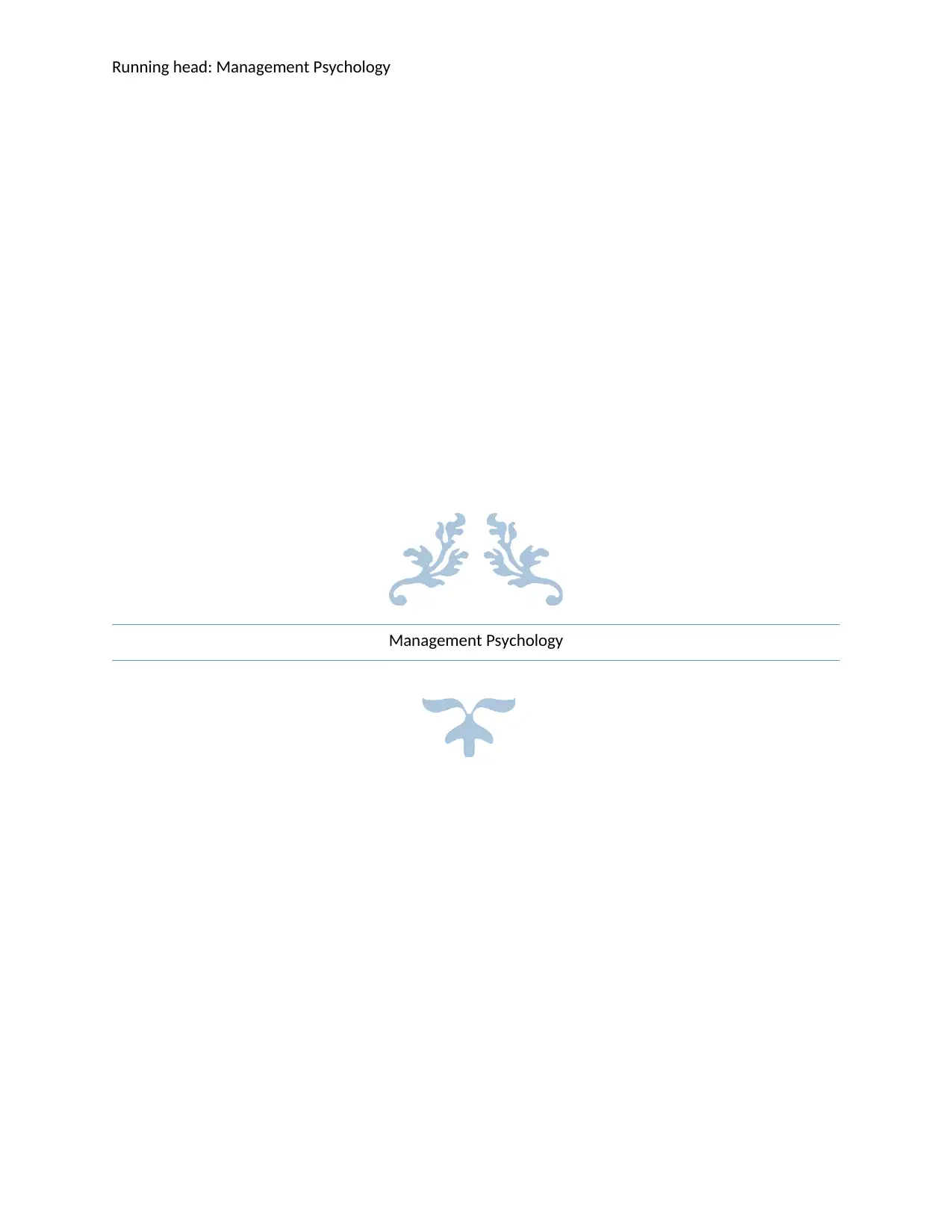
Running head: Management Psychology
Management Psychology
Management Psychology
Paraphrase This Document
Need a fresh take? Get an instant paraphrase of this document with our AI Paraphraser
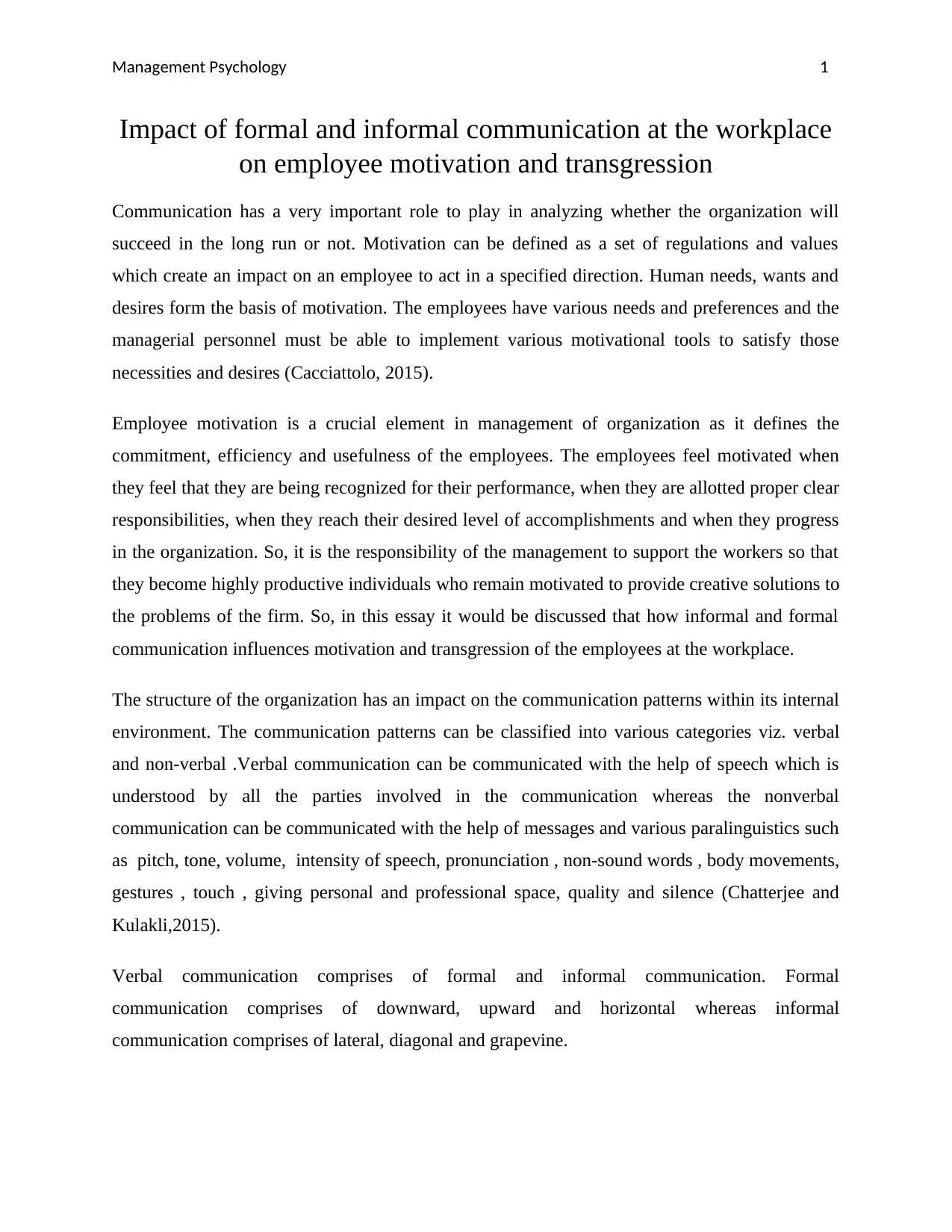
Management Psychology 1
Impact of formal and informal communication at the workplace
on employee motivation and transgression
Communication has a very important role to play in analyzing whether the organization will
succeed in the long run or not. Motivation can be defined as a set of regulations and values
which create an impact on an employee to act in a specified direction. Human needs, wants and
desires form the basis of motivation. The employees have various needs and preferences and the
managerial personnel must be able to implement various motivational tools to satisfy those
necessities and desires (Cacciattolo, 2015).
Employee motivation is a crucial element in management of organization as it defines the
commitment, efficiency and usefulness of the employees. The employees feel motivated when
they feel that they are being recognized for their performance, when they are allotted proper clear
responsibilities, when they reach their desired level of accomplishments and when they progress
in the organization. So, it is the responsibility of the management to support the workers so that
they become highly productive individuals who remain motivated to provide creative solutions to
the problems of the firm. So, in this essay it would be discussed that how informal and formal
communication influences motivation and transgression of the employees at the workplace.
The structure of the organization has an impact on the communication patterns within its internal
environment. The communication patterns can be classified into various categories viz. verbal
and non-verbal .Verbal communication can be communicated with the help of speech which is
understood by all the parties involved in the communication whereas the nonverbal
communication can be communicated with the help of messages and various paralinguistics such
as pitch, tone, volume, intensity of speech, pronunciation , non-sound words , body movements,
gestures , touch , giving personal and professional space, quality and silence (Chatterjee and
Kulakli,2015).
Verbal communication comprises of formal and informal communication. Formal
communication comprises of downward, upward and horizontal whereas informal
communication comprises of lateral, diagonal and grapevine.
Impact of formal and informal communication at the workplace
on employee motivation and transgression
Communication has a very important role to play in analyzing whether the organization will
succeed in the long run or not. Motivation can be defined as a set of regulations and values
which create an impact on an employee to act in a specified direction. Human needs, wants and
desires form the basis of motivation. The employees have various needs and preferences and the
managerial personnel must be able to implement various motivational tools to satisfy those
necessities and desires (Cacciattolo, 2015).
Employee motivation is a crucial element in management of organization as it defines the
commitment, efficiency and usefulness of the employees. The employees feel motivated when
they feel that they are being recognized for their performance, when they are allotted proper clear
responsibilities, when they reach their desired level of accomplishments and when they progress
in the organization. So, it is the responsibility of the management to support the workers so that
they become highly productive individuals who remain motivated to provide creative solutions to
the problems of the firm. So, in this essay it would be discussed that how informal and formal
communication influences motivation and transgression of the employees at the workplace.
The structure of the organization has an impact on the communication patterns within its internal
environment. The communication patterns can be classified into various categories viz. verbal
and non-verbal .Verbal communication can be communicated with the help of speech which is
understood by all the parties involved in the communication whereas the nonverbal
communication can be communicated with the help of messages and various paralinguistics such
as pitch, tone, volume, intensity of speech, pronunciation , non-sound words , body movements,
gestures , touch , giving personal and professional space, quality and silence (Chatterjee and
Kulakli,2015).
Verbal communication comprises of formal and informal communication. Formal
communication comprises of downward, upward and horizontal whereas informal
communication comprises of lateral, diagonal and grapevine.
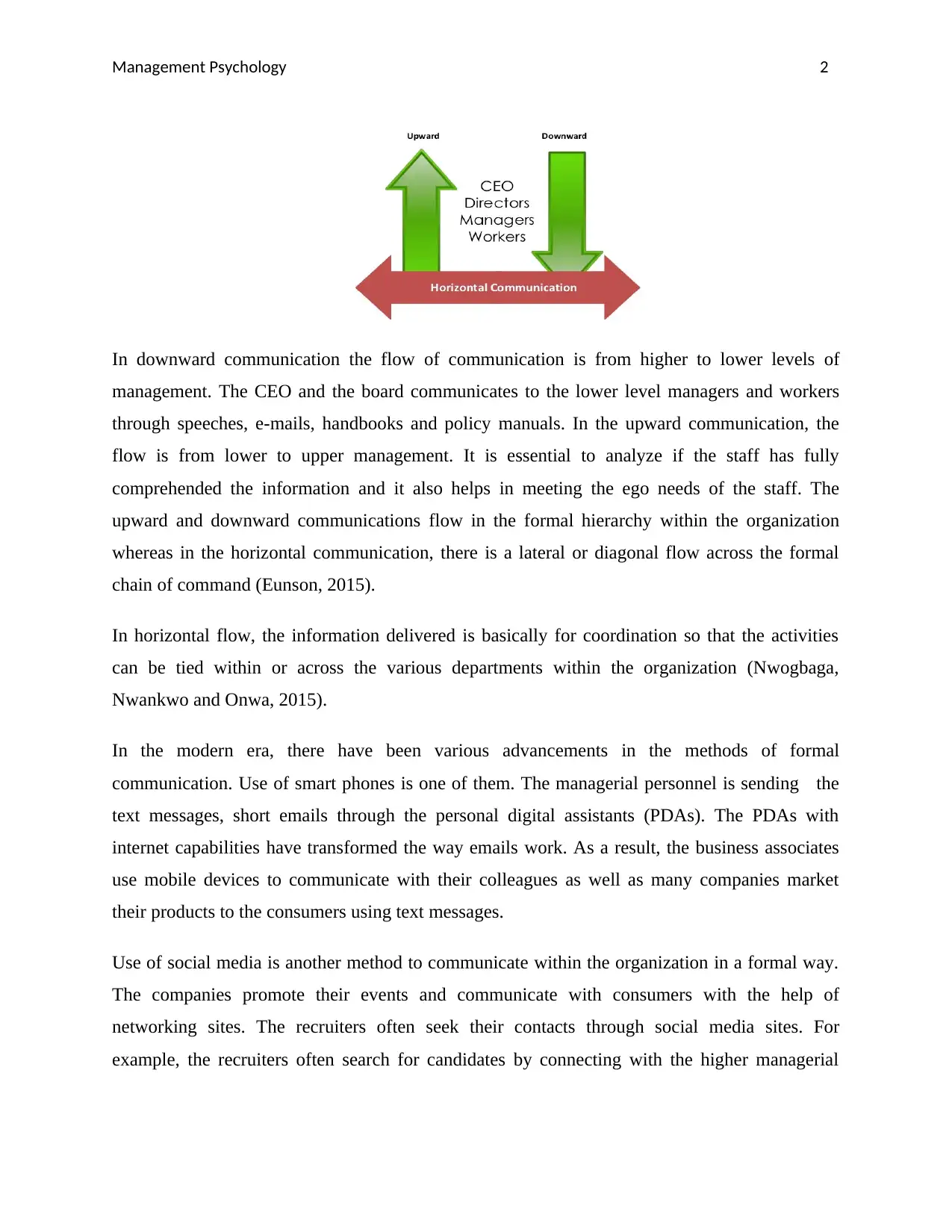
Management Psychology 2
In downward communication the flow of communication is from higher to lower levels of
management. The CEO and the board communicates to the lower level managers and workers
through speeches, e-mails, handbooks and policy manuals. In the upward communication, the
flow is from lower to upper management. It is essential to analyze if the staff has fully
comprehended the information and it also helps in meeting the ego needs of the staff. The
upward and downward communications flow in the formal hierarchy within the organization
whereas in the horizontal communication, there is a lateral or diagonal flow across the formal
chain of command (Eunson, 2015).
In horizontal flow, the information delivered is basically for coordination so that the activities
can be tied within or across the various departments within the organization (Nwogbaga,
Nwankwo and Onwa, 2015).
In the modern era, there have been various advancements in the methods of formal
communication. Use of smart phones is one of them. The managerial personnel is sending the
text messages, short emails through the personal digital assistants (PDAs). The PDAs with
internet capabilities have transformed the way emails work. As a result, the business associates
use mobile devices to communicate with their colleagues as well as many companies market
their products to the consumers using text messages.
Use of social media is another method to communicate within the organization in a formal way.
The companies promote their events and communicate with consumers with the help of
networking sites. The recruiters often seek their contacts through social media sites. For
example, the recruiters often search for candidates by connecting with the higher managerial
In downward communication the flow of communication is from higher to lower levels of
management. The CEO and the board communicates to the lower level managers and workers
through speeches, e-mails, handbooks and policy manuals. In the upward communication, the
flow is from lower to upper management. It is essential to analyze if the staff has fully
comprehended the information and it also helps in meeting the ego needs of the staff. The
upward and downward communications flow in the formal hierarchy within the organization
whereas in the horizontal communication, there is a lateral or diagonal flow across the formal
chain of command (Eunson, 2015).
In horizontal flow, the information delivered is basically for coordination so that the activities
can be tied within or across the various departments within the organization (Nwogbaga,
Nwankwo and Onwa, 2015).
In the modern era, there have been various advancements in the methods of formal
communication. Use of smart phones is one of them. The managerial personnel is sending the
text messages, short emails through the personal digital assistants (PDAs). The PDAs with
internet capabilities have transformed the way emails work. As a result, the business associates
use mobile devices to communicate with their colleagues as well as many companies market
their products to the consumers using text messages.
Use of social media is another method to communicate within the organization in a formal way.
The companies promote their events and communicate with consumers with the help of
networking sites. The recruiters often seek their contacts through social media sites. For
example, the recruiters often search for candidates by connecting with the higher managerial
⊘ This is a preview!⊘
Do you want full access?
Subscribe today to unlock all pages.

Trusted by 1+ million students worldwide
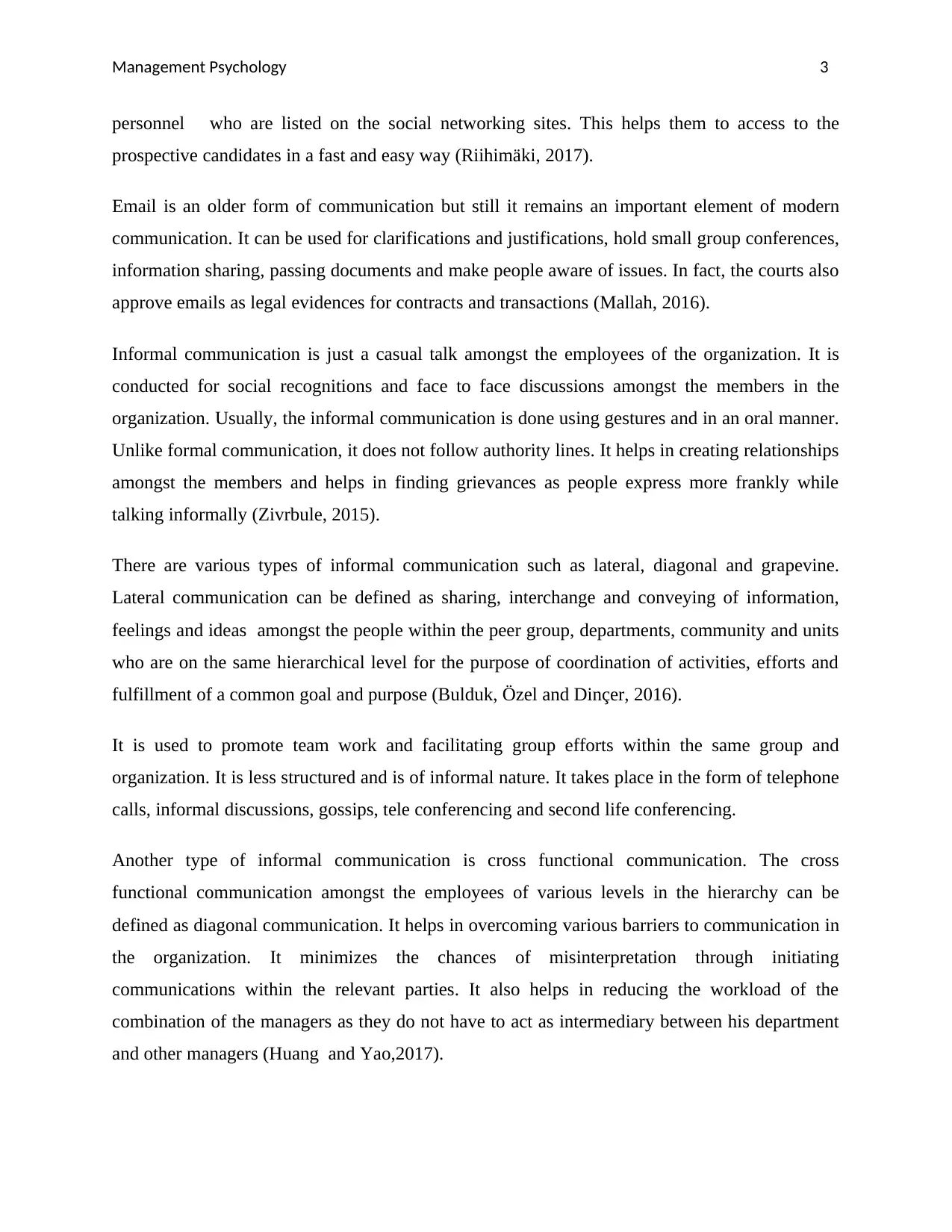
Management Psychology 3
personnel who are listed on the social networking sites. This helps them to access to the
prospective candidates in a fast and easy way (Riihimäki, 2017).
Email is an older form of communication but still it remains an important element of modern
communication. It can be used for clarifications and justifications, hold small group conferences,
information sharing, passing documents and make people aware of issues. In fact, the courts also
approve emails as legal evidences for contracts and transactions (Mallah, 2016).
Informal communication is just a casual talk amongst the employees of the organization. It is
conducted for social recognitions and face to face discussions amongst the members in the
organization. Usually, the informal communication is done using gestures and in an oral manner.
Unlike formal communication, it does not follow authority lines. It helps in creating relationships
amongst the members and helps in finding grievances as people express more frankly while
talking informally (Zivrbule, 2015).
There are various types of informal communication such as lateral, diagonal and grapevine.
Lateral communication can be defined as sharing, interchange and conveying of information,
feelings and ideas amongst the people within the peer group, departments, community and units
who are on the same hierarchical level for the purpose of coordination of activities, efforts and
fulfillment of a common goal and purpose (Bulduk, Özel and Dinçer, 2016).
It is used to promote team work and facilitating group efforts within the same group and
organization. It is less structured and is of informal nature. It takes place in the form of telephone
calls, informal discussions, gossips, tele conferencing and second life conferencing.
Another type of informal communication is cross functional communication. The cross
functional communication amongst the employees of various levels in the hierarchy can be
defined as diagonal communication. It helps in overcoming various barriers to communication in
the organization. It minimizes the chances of misinterpretation through initiating
communications within the relevant parties. It also helps in reducing the workload of the
combination of the managers as they do not have to act as intermediary between his department
and other managers (Huang and Yao,2017).
personnel who are listed on the social networking sites. This helps them to access to the
prospective candidates in a fast and easy way (Riihimäki, 2017).
Email is an older form of communication but still it remains an important element of modern
communication. It can be used for clarifications and justifications, hold small group conferences,
information sharing, passing documents and make people aware of issues. In fact, the courts also
approve emails as legal evidences for contracts and transactions (Mallah, 2016).
Informal communication is just a casual talk amongst the employees of the organization. It is
conducted for social recognitions and face to face discussions amongst the members in the
organization. Usually, the informal communication is done using gestures and in an oral manner.
Unlike formal communication, it does not follow authority lines. It helps in creating relationships
amongst the members and helps in finding grievances as people express more frankly while
talking informally (Zivrbule, 2015).
There are various types of informal communication such as lateral, diagonal and grapevine.
Lateral communication can be defined as sharing, interchange and conveying of information,
feelings and ideas amongst the people within the peer group, departments, community and units
who are on the same hierarchical level for the purpose of coordination of activities, efforts and
fulfillment of a common goal and purpose (Bulduk, Özel and Dinçer, 2016).
It is used to promote team work and facilitating group efforts within the same group and
organization. It is less structured and is of informal nature. It takes place in the form of telephone
calls, informal discussions, gossips, tele conferencing and second life conferencing.
Another type of informal communication is cross functional communication. The cross
functional communication amongst the employees of various levels in the hierarchy can be
defined as diagonal communication. It helps in overcoming various barriers to communication in
the organization. It minimizes the chances of misinterpretation through initiating
communications within the relevant parties. It also helps in reducing the workload of the
combination of the managers as they do not have to act as intermediary between his department
and other managers (Huang and Yao,2017).
Paraphrase This Document
Need a fresh take? Get an instant paraphrase of this document with our AI Paraphraser
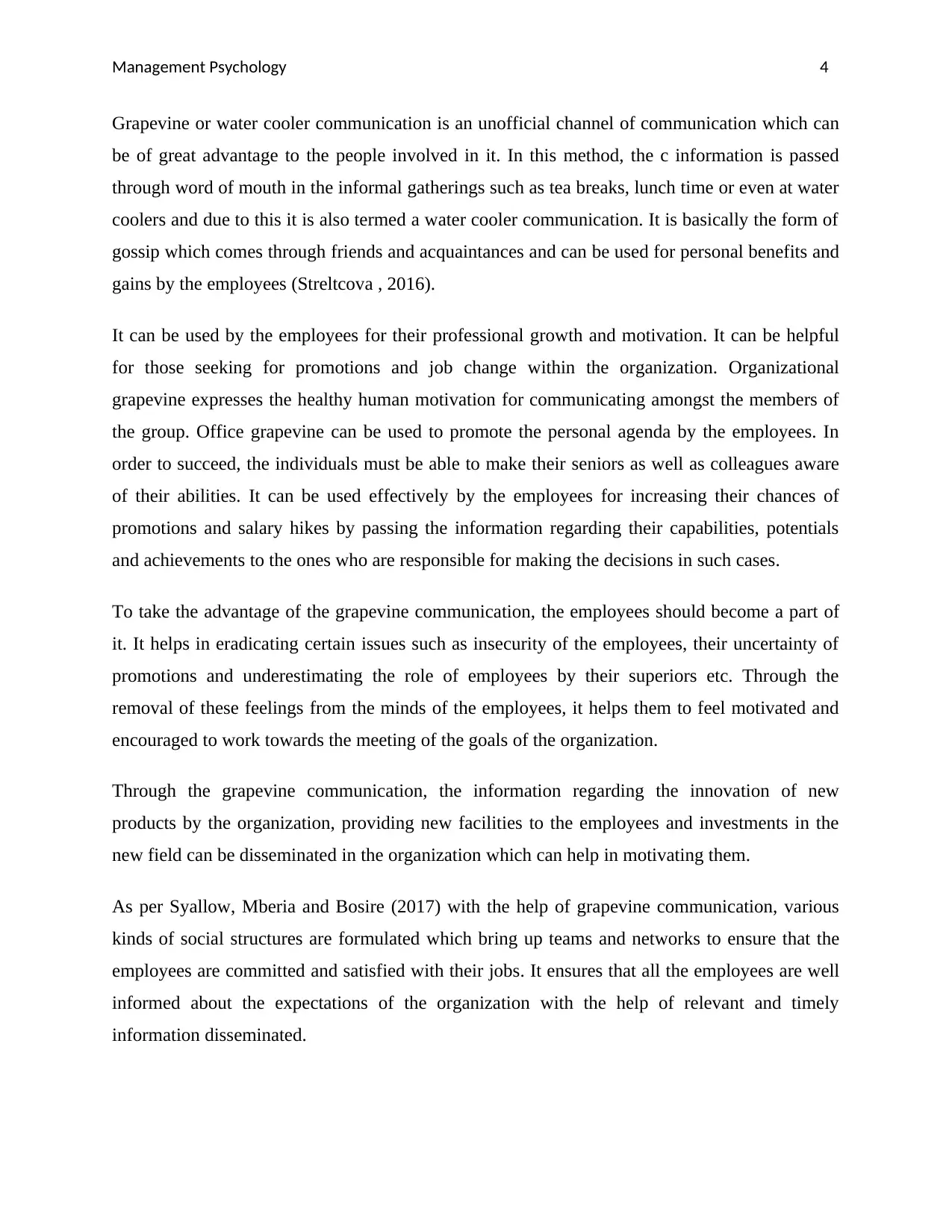
Management Psychology 4
Grapevine or water cooler communication is an unofficial channel of communication which can
be of great advantage to the people involved in it. In this method, the c information is passed
through word of mouth in the informal gatherings such as tea breaks, lunch time or even at water
coolers and due to this it is also termed a water cooler communication. It is basically the form of
gossip which comes through friends and acquaintances and can be used for personal benefits and
gains by the employees (Streltcova , 2016).
It can be used by the employees for their professional growth and motivation. It can be helpful
for those seeking for promotions and job change within the organization. Organizational
grapevine expresses the healthy human motivation for communicating amongst the members of
the group. Office grapevine can be used to promote the personal agenda by the employees. In
order to succeed, the individuals must be able to make their seniors as well as colleagues aware
of their abilities. It can be used effectively by the employees for increasing their chances of
promotions and salary hikes by passing the information regarding their capabilities, potentials
and achievements to the ones who are responsible for making the decisions in such cases.
To take the advantage of the grapevine communication, the employees should become a part of
it. It helps in eradicating certain issues such as insecurity of the employees, their uncertainty of
promotions and underestimating the role of employees by their superiors etc. Through the
removal of these feelings from the minds of the employees, it helps them to feel motivated and
encouraged to work towards the meeting of the goals of the organization.
Through the grapevine communication, the information regarding the innovation of new
products by the organization, providing new facilities to the employees and investments in the
new field can be disseminated in the organization which can help in motivating them.
As per Syallow, Mberia and Bosire (2017) with the help of grapevine communication, various
kinds of social structures are formulated which bring up teams and networks to ensure that the
employees are committed and satisfied with their jobs. It ensures that all the employees are well
informed about the expectations of the organization with the help of relevant and timely
information disseminated.
Grapevine or water cooler communication is an unofficial channel of communication which can
be of great advantage to the people involved in it. In this method, the c information is passed
through word of mouth in the informal gatherings such as tea breaks, lunch time or even at water
coolers and due to this it is also termed a water cooler communication. It is basically the form of
gossip which comes through friends and acquaintances and can be used for personal benefits and
gains by the employees (Streltcova , 2016).
It can be used by the employees for their professional growth and motivation. It can be helpful
for those seeking for promotions and job change within the organization. Organizational
grapevine expresses the healthy human motivation for communicating amongst the members of
the group. Office grapevine can be used to promote the personal agenda by the employees. In
order to succeed, the individuals must be able to make their seniors as well as colleagues aware
of their abilities. It can be used effectively by the employees for increasing their chances of
promotions and salary hikes by passing the information regarding their capabilities, potentials
and achievements to the ones who are responsible for making the decisions in such cases.
To take the advantage of the grapevine communication, the employees should become a part of
it. It helps in eradicating certain issues such as insecurity of the employees, their uncertainty of
promotions and underestimating the role of employees by their superiors etc. Through the
removal of these feelings from the minds of the employees, it helps them to feel motivated and
encouraged to work towards the meeting of the goals of the organization.
Through the grapevine communication, the information regarding the innovation of new
products by the organization, providing new facilities to the employees and investments in the
new field can be disseminated in the organization which can help in motivating them.
As per Syallow, Mberia and Bosire (2017) with the help of grapevine communication, various
kinds of social structures are formulated which bring up teams and networks to ensure that the
employees are committed and satisfied with their jobs. It ensures that all the employees are well
informed about the expectations of the organization with the help of relevant and timely
information disseminated.
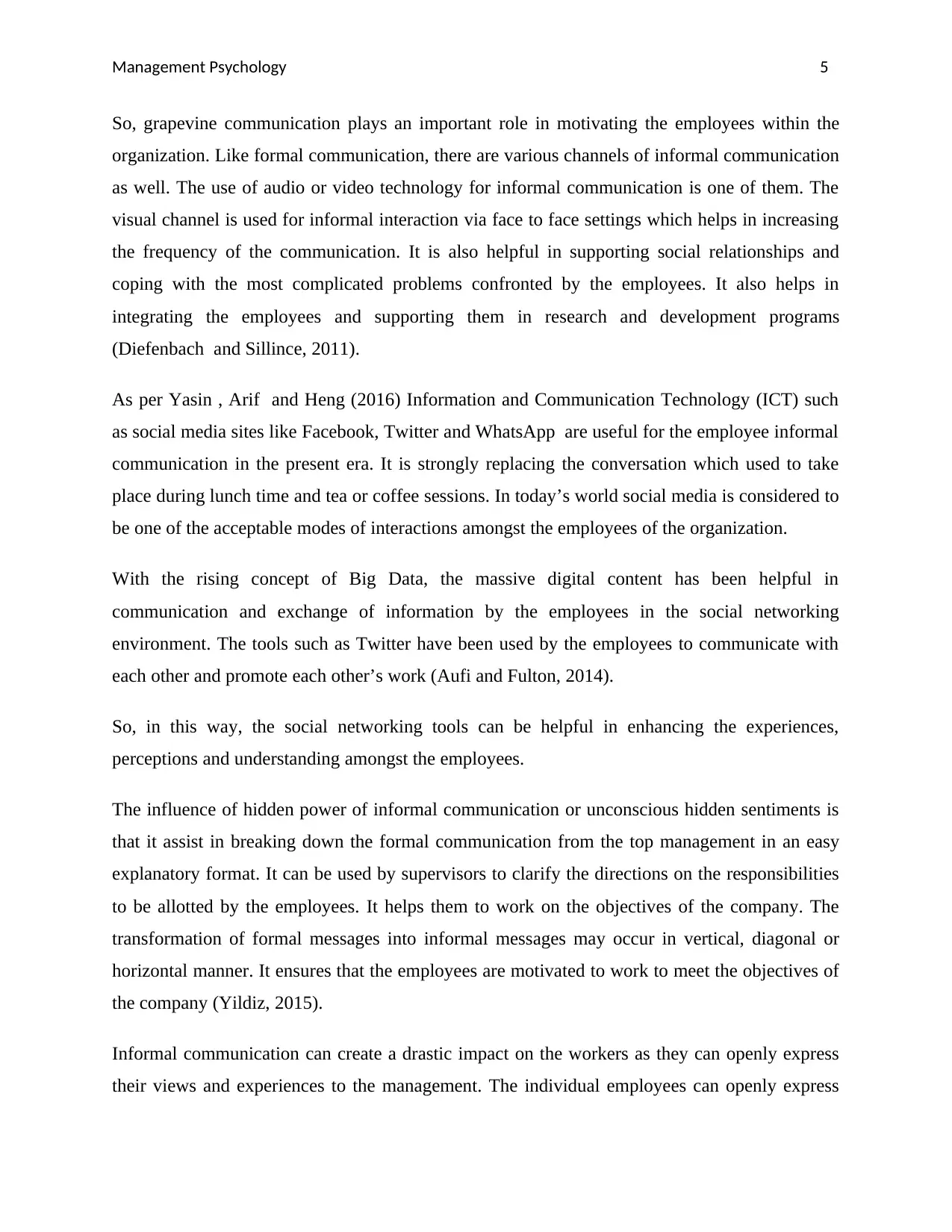
Management Psychology 5
So, grapevine communication plays an important role in motivating the employees within the
organization. Like formal communication, there are various channels of informal communication
as well. The use of audio or video technology for informal communication is one of them. The
visual channel is used for informal interaction via face to face settings which helps in increasing
the frequency of the communication. It is also helpful in supporting social relationships and
coping with the most complicated problems confronted by the employees. It also helps in
integrating the employees and supporting them in research and development programs
(Diefenbach and Sillince, 2011).
As per Yasin , Arif and Heng (2016) Information and Communication Technology (ICT) such
as social media sites like Facebook, Twitter and WhatsApp are useful for the employee informal
communication in the present era. It is strongly replacing the conversation which used to take
place during lunch time and tea or coffee sessions. In today’s world social media is considered to
be one of the acceptable modes of interactions amongst the employees of the organization.
With the rising concept of Big Data, the massive digital content has been helpful in
communication and exchange of information by the employees in the social networking
environment. The tools such as Twitter have been used by the employees to communicate with
each other and promote each other’s work (Aufi and Fulton, 2014).
So, in this way, the social networking tools can be helpful in enhancing the experiences,
perceptions and understanding amongst the employees.
The influence of hidden power of informal communication or unconscious hidden sentiments is
that it assist in breaking down the formal communication from the top management in an easy
explanatory format. It can be used by supervisors to clarify the directions on the responsibilities
to be allotted by the employees. It helps them to work on the objectives of the company. The
transformation of formal messages into informal messages may occur in vertical, diagonal or
horizontal manner. It ensures that the employees are motivated to work to meet the objectives of
the company (Yildiz, 2015).
Informal communication can create a drastic impact on the workers as they can openly express
their views and experiences to the management. The individual employees can openly express
So, grapevine communication plays an important role in motivating the employees within the
organization. Like formal communication, there are various channels of informal communication
as well. The use of audio or video technology for informal communication is one of them. The
visual channel is used for informal interaction via face to face settings which helps in increasing
the frequency of the communication. It is also helpful in supporting social relationships and
coping with the most complicated problems confronted by the employees. It also helps in
integrating the employees and supporting them in research and development programs
(Diefenbach and Sillince, 2011).
As per Yasin , Arif and Heng (2016) Information and Communication Technology (ICT) such
as social media sites like Facebook, Twitter and WhatsApp are useful for the employee informal
communication in the present era. It is strongly replacing the conversation which used to take
place during lunch time and tea or coffee sessions. In today’s world social media is considered to
be one of the acceptable modes of interactions amongst the employees of the organization.
With the rising concept of Big Data, the massive digital content has been helpful in
communication and exchange of information by the employees in the social networking
environment. The tools such as Twitter have been used by the employees to communicate with
each other and promote each other’s work (Aufi and Fulton, 2014).
So, in this way, the social networking tools can be helpful in enhancing the experiences,
perceptions and understanding amongst the employees.
The influence of hidden power of informal communication or unconscious hidden sentiments is
that it assist in breaking down the formal communication from the top management in an easy
explanatory format. It can be used by supervisors to clarify the directions on the responsibilities
to be allotted by the employees. It helps them to work on the objectives of the company. The
transformation of formal messages into informal messages may occur in vertical, diagonal or
horizontal manner. It ensures that the employees are motivated to work to meet the objectives of
the company (Yildiz, 2015).
Informal communication can create a drastic impact on the workers as they can openly express
their views and experiences to the management. The individual employees can openly express
⊘ This is a preview!⊘
Do you want full access?
Subscribe today to unlock all pages.

Trusted by 1+ million students worldwide
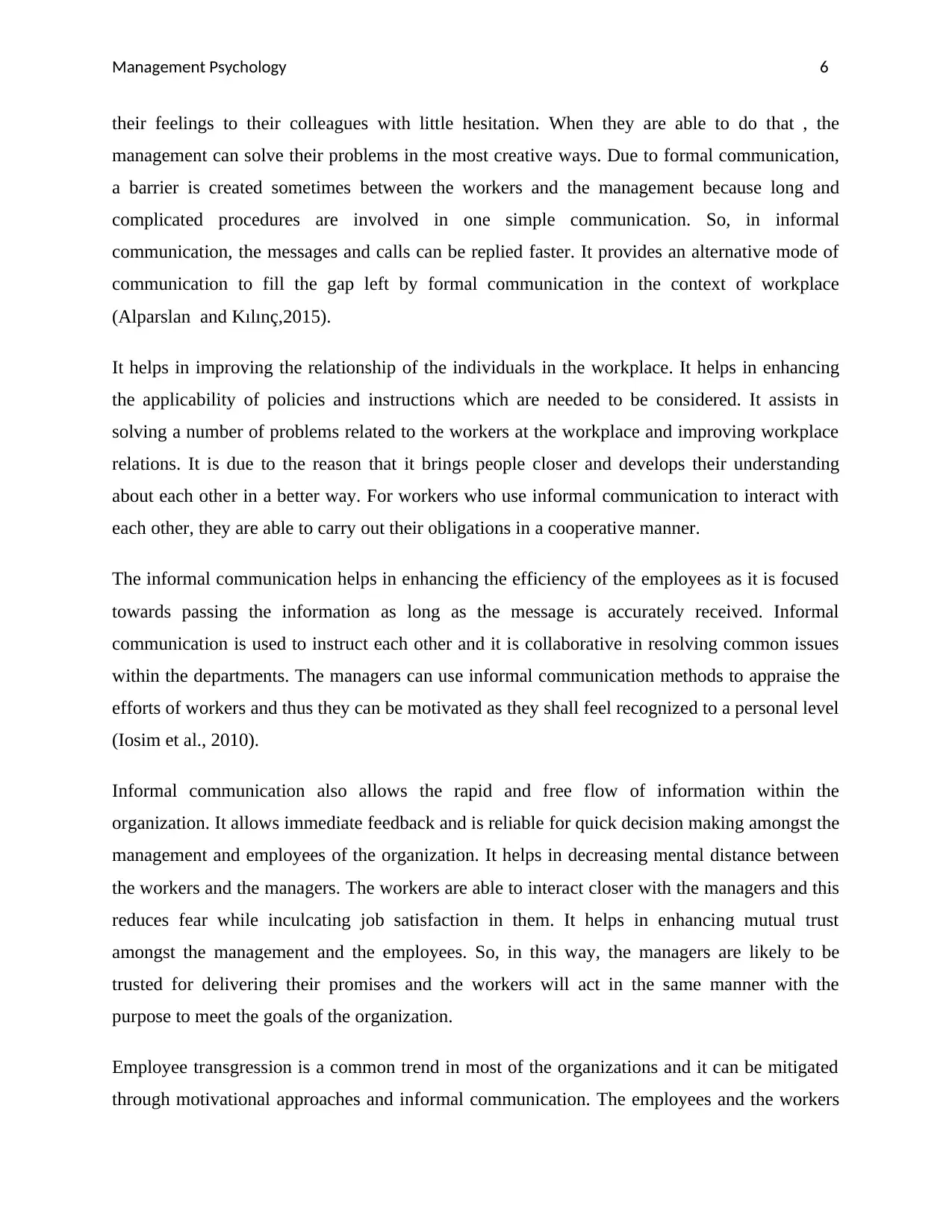
Management Psychology 6
their feelings to their colleagues with little hesitation. When they are able to do that , the
management can solve their problems in the most creative ways. Due to formal communication,
a barrier is created sometimes between the workers and the management because long and
complicated procedures are involved in one simple communication. So, in informal
communication, the messages and calls can be replied faster. It provides an alternative mode of
communication to fill the gap left by formal communication in the context of workplace
(Alparslan and Kılınç,2015).
It helps in improving the relationship of the individuals in the workplace. It helps in enhancing
the applicability of policies and instructions which are needed to be considered. It assists in
solving a number of problems related to the workers at the workplace and improving workplace
relations. It is due to the reason that it brings people closer and develops their understanding
about each other in a better way. For workers who use informal communication to interact with
each other, they are able to carry out their obligations in a cooperative manner.
The informal communication helps in enhancing the efficiency of the employees as it is focused
towards passing the information as long as the message is accurately received. Informal
communication is used to instruct each other and it is collaborative in resolving common issues
within the departments. The managers can use informal communication methods to appraise the
efforts of workers and thus they can be motivated as they shall feel recognized to a personal level
(Iosim et al., 2010).
Informal communication also allows the rapid and free flow of information within the
organization. It allows immediate feedback and is reliable for quick decision making amongst the
management and employees of the organization. It helps in decreasing mental distance between
the workers and the managers. The workers are able to interact closer with the managers and this
reduces fear while inculcating job satisfaction in them. It helps in enhancing mutual trust
amongst the management and the employees. So, in this way, the managers are likely to be
trusted for delivering their promises and the workers will act in the same manner with the
purpose to meet the goals of the organization.
Employee transgression is a common trend in most of the organizations and it can be mitigated
through motivational approaches and informal communication. The employees and the workers
their feelings to their colleagues with little hesitation. When they are able to do that , the
management can solve their problems in the most creative ways. Due to formal communication,
a barrier is created sometimes between the workers and the management because long and
complicated procedures are involved in one simple communication. So, in informal
communication, the messages and calls can be replied faster. It provides an alternative mode of
communication to fill the gap left by formal communication in the context of workplace
(Alparslan and Kılınç,2015).
It helps in improving the relationship of the individuals in the workplace. It helps in enhancing
the applicability of policies and instructions which are needed to be considered. It assists in
solving a number of problems related to the workers at the workplace and improving workplace
relations. It is due to the reason that it brings people closer and develops their understanding
about each other in a better way. For workers who use informal communication to interact with
each other, they are able to carry out their obligations in a cooperative manner.
The informal communication helps in enhancing the efficiency of the employees as it is focused
towards passing the information as long as the message is accurately received. Informal
communication is used to instruct each other and it is collaborative in resolving common issues
within the departments. The managers can use informal communication methods to appraise the
efforts of workers and thus they can be motivated as they shall feel recognized to a personal level
(Iosim et al., 2010).
Informal communication also allows the rapid and free flow of information within the
organization. It allows immediate feedback and is reliable for quick decision making amongst the
management and employees of the organization. It helps in decreasing mental distance between
the workers and the managers. The workers are able to interact closer with the managers and this
reduces fear while inculcating job satisfaction in them. It helps in enhancing mutual trust
amongst the management and the employees. So, in this way, the managers are likely to be
trusted for delivering their promises and the workers will act in the same manner with the
purpose to meet the goals of the organization.
Employee transgression is a common trend in most of the organizations and it can be mitigated
through motivational approaches and informal communication. The employees and the workers
Paraphrase This Document
Need a fresh take? Get an instant paraphrase of this document with our AI Paraphraser
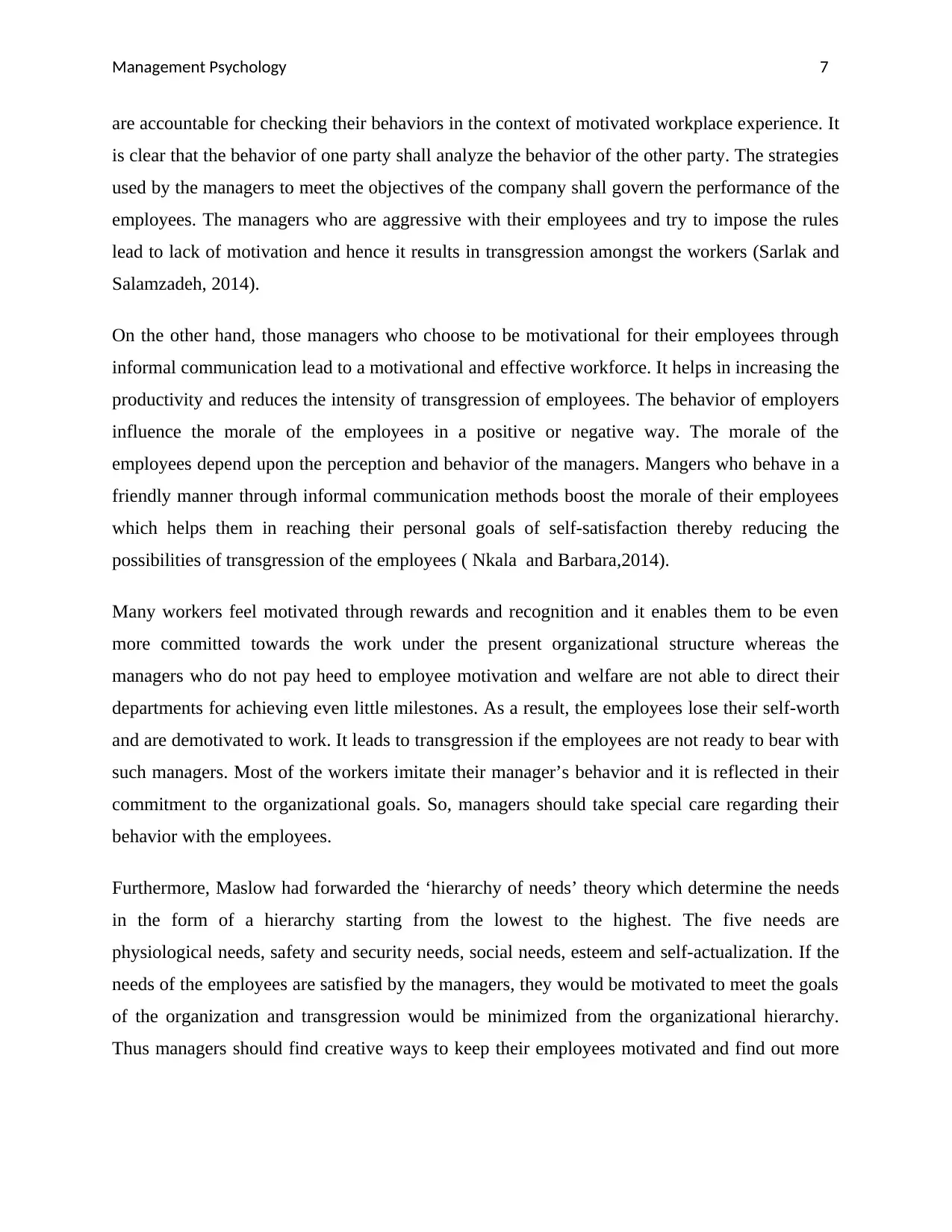
Management Psychology 7
are accountable for checking their behaviors in the context of motivated workplace experience. It
is clear that the behavior of one party shall analyze the behavior of the other party. The strategies
used by the managers to meet the objectives of the company shall govern the performance of the
employees. The managers who are aggressive with their employees and try to impose the rules
lead to lack of motivation and hence it results in transgression amongst the workers (Sarlak and
Salamzadeh, 2014).
On the other hand, those managers who choose to be motivational for their employees through
informal communication lead to a motivational and effective workforce. It helps in increasing the
productivity and reduces the intensity of transgression of employees. The behavior of employers
influence the morale of the employees in a positive or negative way. The morale of the
employees depend upon the perception and behavior of the managers. Mangers who behave in a
friendly manner through informal communication methods boost the morale of their employees
which helps them in reaching their personal goals of self-satisfaction thereby reducing the
possibilities of transgression of the employees ( Nkala and Barbara,2014).
Many workers feel motivated through rewards and recognition and it enables them to be even
more committed towards the work under the present organizational structure whereas the
managers who do not pay heed to employee motivation and welfare are not able to direct their
departments for achieving even little milestones. As a result, the employees lose their self-worth
and are demotivated to work. It leads to transgression if the employees are not ready to bear with
such managers. Most of the workers imitate their manager’s behavior and it is reflected in their
commitment to the organizational goals. So, managers should take special care regarding their
behavior with the employees.
Furthermore, Maslow had forwarded the ‘hierarchy of needs’ theory which determine the needs
in the form of a hierarchy starting from the lowest to the highest. The five needs are
physiological needs, safety and security needs, social needs, esteem and self-actualization. If the
needs of the employees are satisfied by the managers, they would be motivated to meet the goals
of the organization and transgression would be minimized from the organizational hierarchy.
Thus managers should find creative ways to keep their employees motivated and find out more
are accountable for checking their behaviors in the context of motivated workplace experience. It
is clear that the behavior of one party shall analyze the behavior of the other party. The strategies
used by the managers to meet the objectives of the company shall govern the performance of the
employees. The managers who are aggressive with their employees and try to impose the rules
lead to lack of motivation and hence it results in transgression amongst the workers (Sarlak and
Salamzadeh, 2014).
On the other hand, those managers who choose to be motivational for their employees through
informal communication lead to a motivational and effective workforce. It helps in increasing the
productivity and reduces the intensity of transgression of employees. The behavior of employers
influence the morale of the employees in a positive or negative way. The morale of the
employees depend upon the perception and behavior of the managers. Mangers who behave in a
friendly manner through informal communication methods boost the morale of their employees
which helps them in reaching their personal goals of self-satisfaction thereby reducing the
possibilities of transgression of the employees ( Nkala and Barbara,2014).
Many workers feel motivated through rewards and recognition and it enables them to be even
more committed towards the work under the present organizational structure whereas the
managers who do not pay heed to employee motivation and welfare are not able to direct their
departments for achieving even little milestones. As a result, the employees lose their self-worth
and are demotivated to work. It leads to transgression if the employees are not ready to bear with
such managers. Most of the workers imitate their manager’s behavior and it is reflected in their
commitment to the organizational goals. So, managers should take special care regarding their
behavior with the employees.
Furthermore, Maslow had forwarded the ‘hierarchy of needs’ theory which determine the needs
in the form of a hierarchy starting from the lowest to the highest. The five needs are
physiological needs, safety and security needs, social needs, esteem and self-actualization. If the
needs of the employees are satisfied by the managers, they would be motivated to meet the goals
of the organization and transgression would be minimized from the organizational hierarchy.
Thus managers should find creative ways to keep their employees motivated and find out more
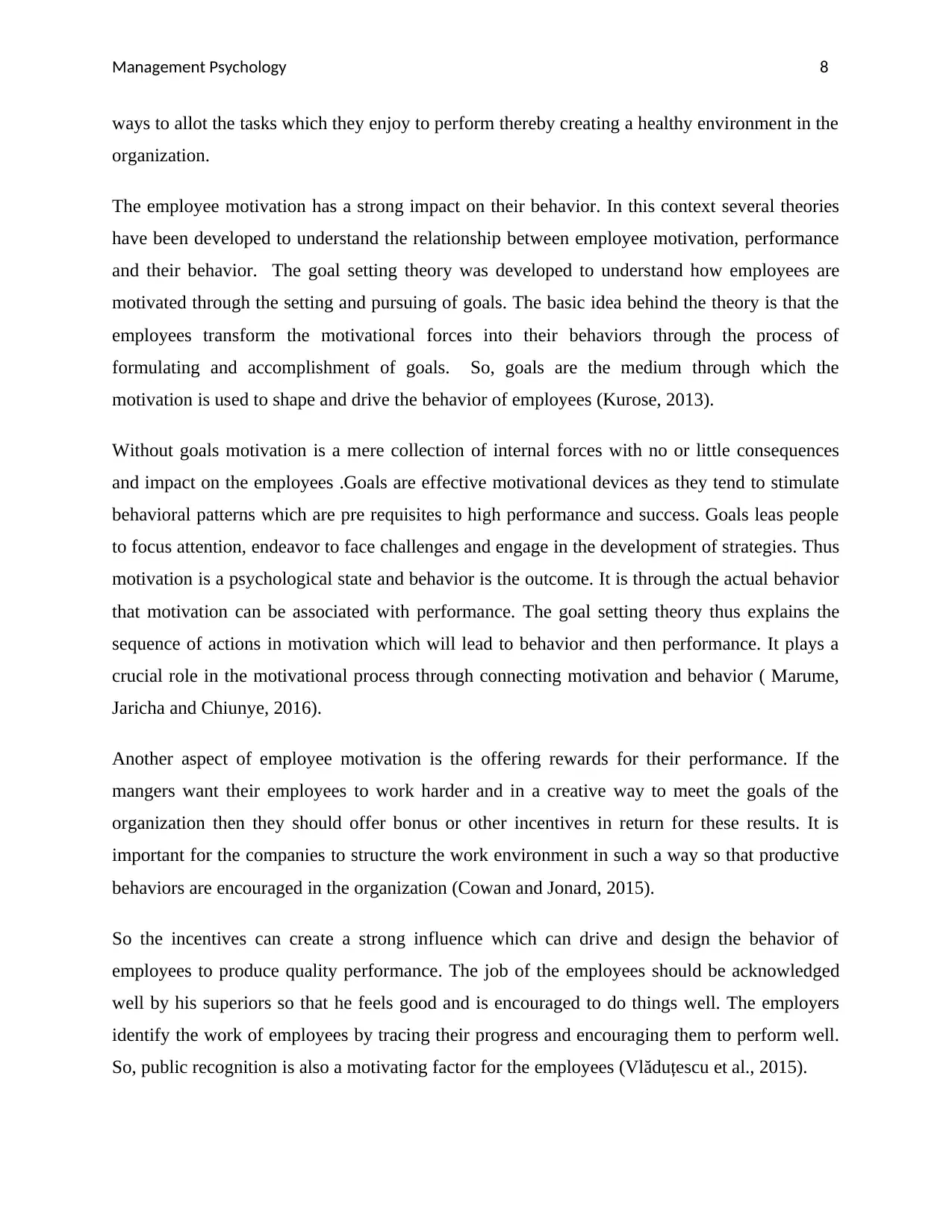
Management Psychology 8
ways to allot the tasks which they enjoy to perform thereby creating a healthy environment in the
organization.
The employee motivation has a strong impact on their behavior. In this context several theories
have been developed to understand the relationship between employee motivation, performance
and their behavior. The goal setting theory was developed to understand how employees are
motivated through the setting and pursuing of goals. The basic idea behind the theory is that the
employees transform the motivational forces into their behaviors through the process of
formulating and accomplishment of goals. So, goals are the medium through which the
motivation is used to shape and drive the behavior of employees (Kurose, 2013).
Without goals motivation is a mere collection of internal forces with no or little consequences
and impact on the employees .Goals are effective motivational devices as they tend to stimulate
behavioral patterns which are pre requisites to high performance and success. Goals leas people
to focus attention, endeavor to face challenges and engage in the development of strategies. Thus
motivation is a psychological state and behavior is the outcome. It is through the actual behavior
that motivation can be associated with performance. The goal setting theory thus explains the
sequence of actions in motivation which will lead to behavior and then performance. It plays a
crucial role in the motivational process through connecting motivation and behavior ( Marume,
Jaricha and Chiunye, 2016).
Another aspect of employee motivation is the offering rewards for their performance. If the
mangers want their employees to work harder and in a creative way to meet the goals of the
organization then they should offer bonus or other incentives in return for these results. It is
important for the companies to structure the work environment in such a way so that productive
behaviors are encouraged in the organization (Cowan and Jonard, 2015).
So the incentives can create a strong influence which can drive and design the behavior of
employees to produce quality performance. The job of the employees should be acknowledged
well by his superiors so that he feels good and is encouraged to do things well. The employers
identify the work of employees by tracing their progress and encouraging them to perform well.
So, public recognition is also a motivating factor for the employees (Vlăduțescu et al., 2015).
ways to allot the tasks which they enjoy to perform thereby creating a healthy environment in the
organization.
The employee motivation has a strong impact on their behavior. In this context several theories
have been developed to understand the relationship between employee motivation, performance
and their behavior. The goal setting theory was developed to understand how employees are
motivated through the setting and pursuing of goals. The basic idea behind the theory is that the
employees transform the motivational forces into their behaviors through the process of
formulating and accomplishment of goals. So, goals are the medium through which the
motivation is used to shape and drive the behavior of employees (Kurose, 2013).
Without goals motivation is a mere collection of internal forces with no or little consequences
and impact on the employees .Goals are effective motivational devices as they tend to stimulate
behavioral patterns which are pre requisites to high performance and success. Goals leas people
to focus attention, endeavor to face challenges and engage in the development of strategies. Thus
motivation is a psychological state and behavior is the outcome. It is through the actual behavior
that motivation can be associated with performance. The goal setting theory thus explains the
sequence of actions in motivation which will lead to behavior and then performance. It plays a
crucial role in the motivational process through connecting motivation and behavior ( Marume,
Jaricha and Chiunye, 2016).
Another aspect of employee motivation is the offering rewards for their performance. If the
mangers want their employees to work harder and in a creative way to meet the goals of the
organization then they should offer bonus or other incentives in return for these results. It is
important for the companies to structure the work environment in such a way so that productive
behaviors are encouraged in the organization (Cowan and Jonard, 2015).
So the incentives can create a strong influence which can drive and design the behavior of
employees to produce quality performance. The job of the employees should be acknowledged
well by his superiors so that he feels good and is encouraged to do things well. The employers
identify the work of employees by tracing their progress and encouraging them to perform well.
So, public recognition is also a motivating factor for the employees (Vlăduțescu et al., 2015).
⊘ This is a preview!⊘
Do you want full access?
Subscribe today to unlock all pages.

Trusted by 1+ million students worldwide
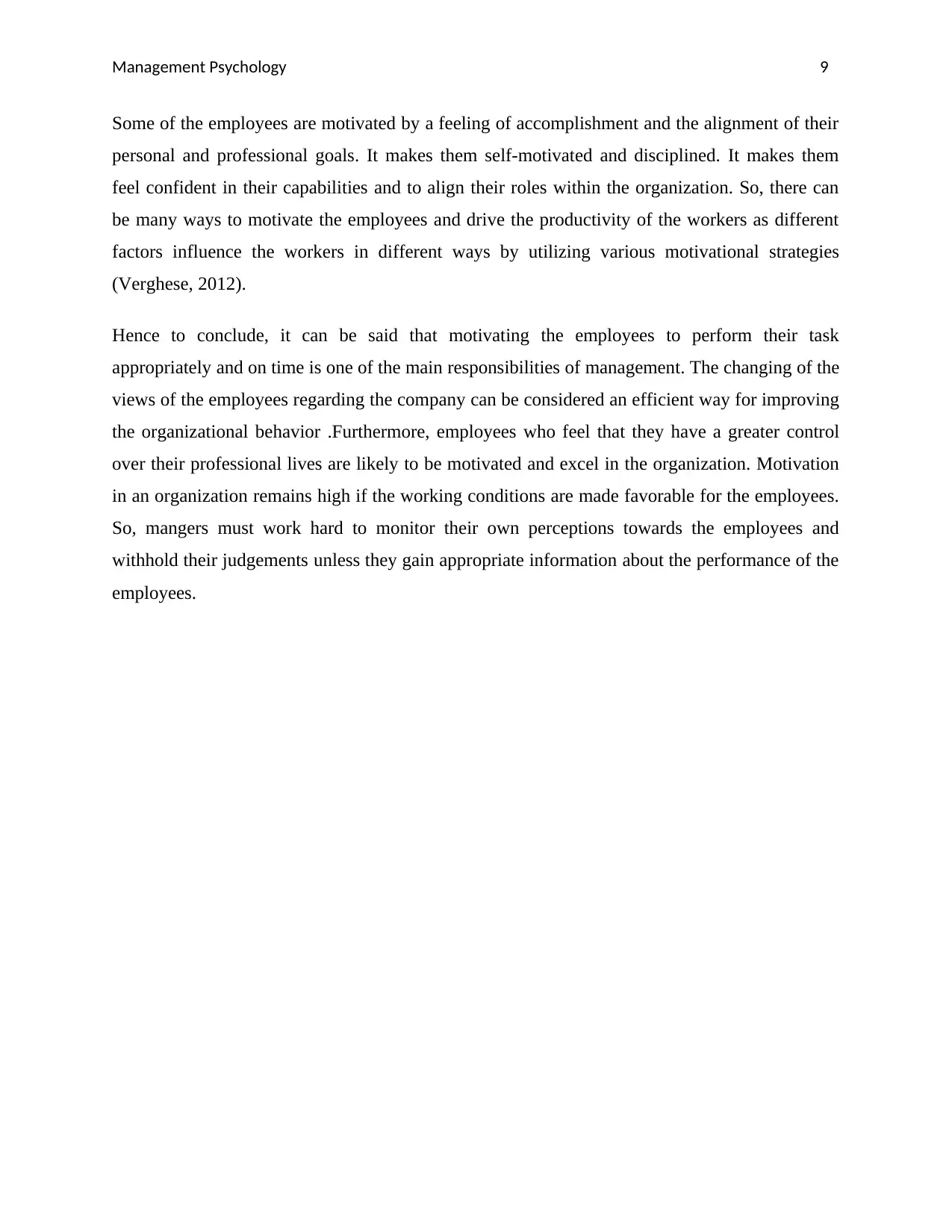
Management Psychology 9
Some of the employees are motivated by a feeling of accomplishment and the alignment of their
personal and professional goals. It makes them self-motivated and disciplined. It makes them
feel confident in their capabilities and to align their roles within the organization. So, there can
be many ways to motivate the employees and drive the productivity of the workers as different
factors influence the workers in different ways by utilizing various motivational strategies
(Verghese, 2012).
Hence to conclude, it can be said that motivating the employees to perform their task
appropriately and on time is one of the main responsibilities of management. The changing of the
views of the employees regarding the company can be considered an efficient way for improving
the organizational behavior .Furthermore, employees who feel that they have a greater control
over their professional lives are likely to be motivated and excel in the organization. Motivation
in an organization remains high if the working conditions are made favorable for the employees.
So, mangers must work hard to monitor their own perceptions towards the employees and
withhold their judgements unless they gain appropriate information about the performance of the
employees.
Some of the employees are motivated by a feeling of accomplishment and the alignment of their
personal and professional goals. It makes them self-motivated and disciplined. It makes them
feel confident in their capabilities and to align their roles within the organization. So, there can
be many ways to motivate the employees and drive the productivity of the workers as different
factors influence the workers in different ways by utilizing various motivational strategies
(Verghese, 2012).
Hence to conclude, it can be said that motivating the employees to perform their task
appropriately and on time is one of the main responsibilities of management. The changing of the
views of the employees regarding the company can be considered an efficient way for improving
the organizational behavior .Furthermore, employees who feel that they have a greater control
over their professional lives are likely to be motivated and excel in the organization. Motivation
in an organization remains high if the working conditions are made favorable for the employees.
So, mangers must work hard to monitor their own perceptions towards the employees and
withhold their judgements unless they gain appropriate information about the performance of the
employees.
Paraphrase This Document
Need a fresh take? Get an instant paraphrase of this document with our AI Paraphraser
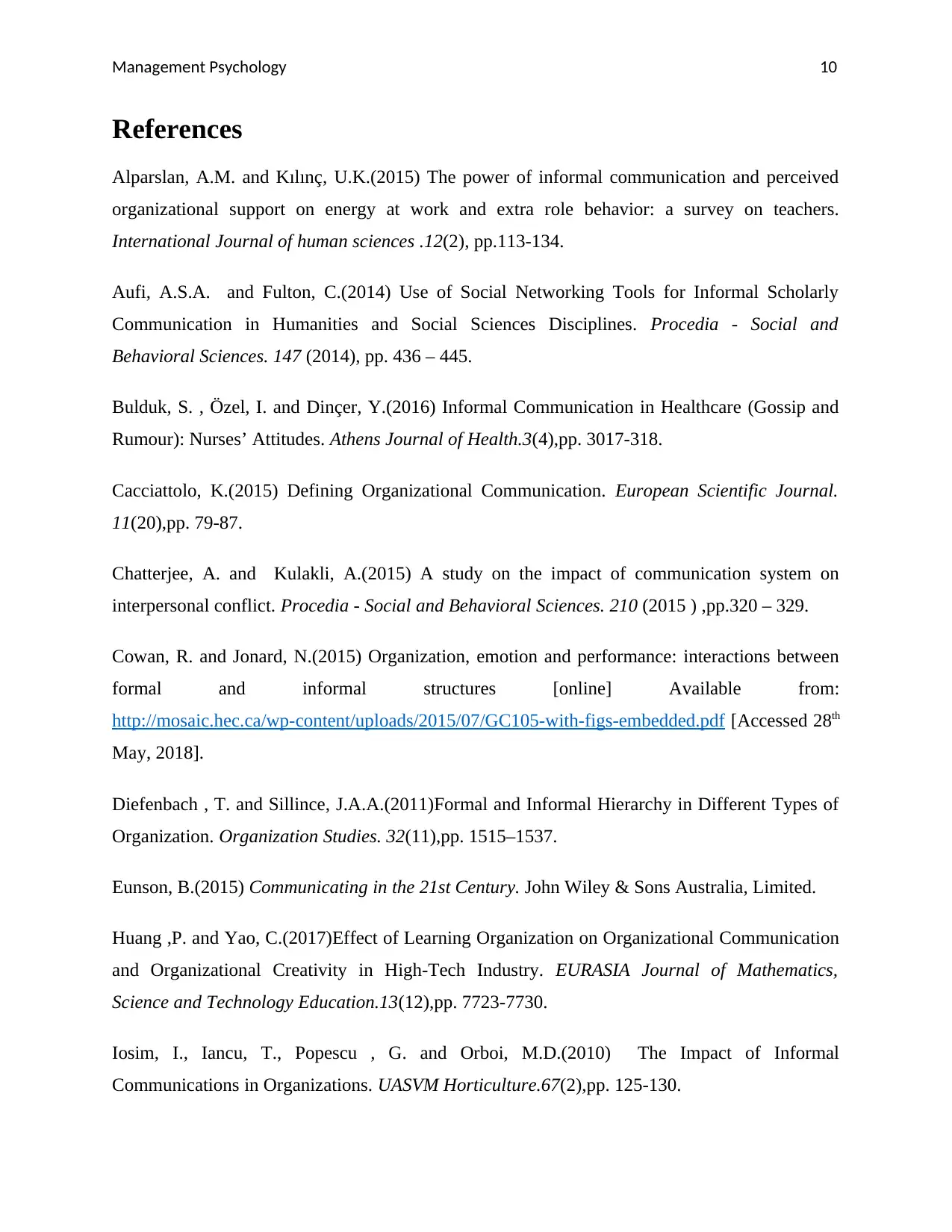
Management Psychology 10
References
Alparslan, A.M. and Kılınç, U.K.(2015) The power of informal communication and perceived
organizational support on energy at work and extra role behavior: a survey on teachers.
International Journal of human sciences .12(2), pp.113-134.
Aufi, A.S.A. and Fulton, C.(2014) Use of Social Networking Tools for Informal Scholarly
Communication in Humanities and Social Sciences Disciplines. Procedia - Social and
Behavioral Sciences. 147 (2014), pp. 436 – 445.
Bulduk, S. , Özel, I. and Dinçer, Y.(2016) Informal Communication in Healthcare (Gossip and
Rumour): Nurses’ Attitudes. Athens Journal of Health.3(4),pp. 3017-318.
Cacciattolo, K.(2015) Defining Organizational Communication. European Scientific Journal.
11(20),pp. 79-87.
Chatterjee, A. and Kulakli, A.(2015) A study on the impact of communication system on
interpersonal conflict. Procedia - Social and Behavioral Sciences. 210 (2015 ) ,pp.320 – 329.
Cowan, R. and Jonard, N.(2015) Organization, emotion and performance: interactions between
formal and informal structures [online] Available from:
http://mosaic.hec.ca/wp-content/uploads/2015/07/GC105-with-figs-embedded.pdf [Accessed 28th
May, 2018].
Diefenbach , T. and Sillince, J.A.A.(2011)Formal and Informal Hierarchy in Different Types of
Organization. Organization Studies. 32(11),pp. 1515–1537.
Eunson, B.(2015) Communicating in the 21st Century. John Wiley & Sons Australia, Limited.
Huang ,P. and Yao, C.(2017)Effect of Learning Organization on Organizational Communication
and Organizational Creativity in High-Tech Industry. EURASIA Journal of Mathematics,
Science and Technology Education.13(12),pp. 7723-7730.
Iosim, I., Iancu, T., Popescu , G. and Orboi, M.D.(2010) The Impact of Informal
Communications in Organizations. UASVM Horticulture.67(2),pp. 125-130.
References
Alparslan, A.M. and Kılınç, U.K.(2015) The power of informal communication and perceived
organizational support on energy at work and extra role behavior: a survey on teachers.
International Journal of human sciences .12(2), pp.113-134.
Aufi, A.S.A. and Fulton, C.(2014) Use of Social Networking Tools for Informal Scholarly
Communication in Humanities and Social Sciences Disciplines. Procedia - Social and
Behavioral Sciences. 147 (2014), pp. 436 – 445.
Bulduk, S. , Özel, I. and Dinçer, Y.(2016) Informal Communication in Healthcare (Gossip and
Rumour): Nurses’ Attitudes. Athens Journal of Health.3(4),pp. 3017-318.
Cacciattolo, K.(2015) Defining Organizational Communication. European Scientific Journal.
11(20),pp. 79-87.
Chatterjee, A. and Kulakli, A.(2015) A study on the impact of communication system on
interpersonal conflict. Procedia - Social and Behavioral Sciences. 210 (2015 ) ,pp.320 – 329.
Cowan, R. and Jonard, N.(2015) Organization, emotion and performance: interactions between
formal and informal structures [online] Available from:
http://mosaic.hec.ca/wp-content/uploads/2015/07/GC105-with-figs-embedded.pdf [Accessed 28th
May, 2018].
Diefenbach , T. and Sillince, J.A.A.(2011)Formal and Informal Hierarchy in Different Types of
Organization. Organization Studies. 32(11),pp. 1515–1537.
Eunson, B.(2015) Communicating in the 21st Century. John Wiley & Sons Australia, Limited.
Huang ,P. and Yao, C.(2017)Effect of Learning Organization on Organizational Communication
and Organizational Creativity in High-Tech Industry. EURASIA Journal of Mathematics,
Science and Technology Education.13(12),pp. 7723-7730.
Iosim, I., Iancu, T., Popescu , G. and Orboi, M.D.(2010) The Impact of Informal
Communications in Organizations. UASVM Horticulture.67(2),pp. 125-130.
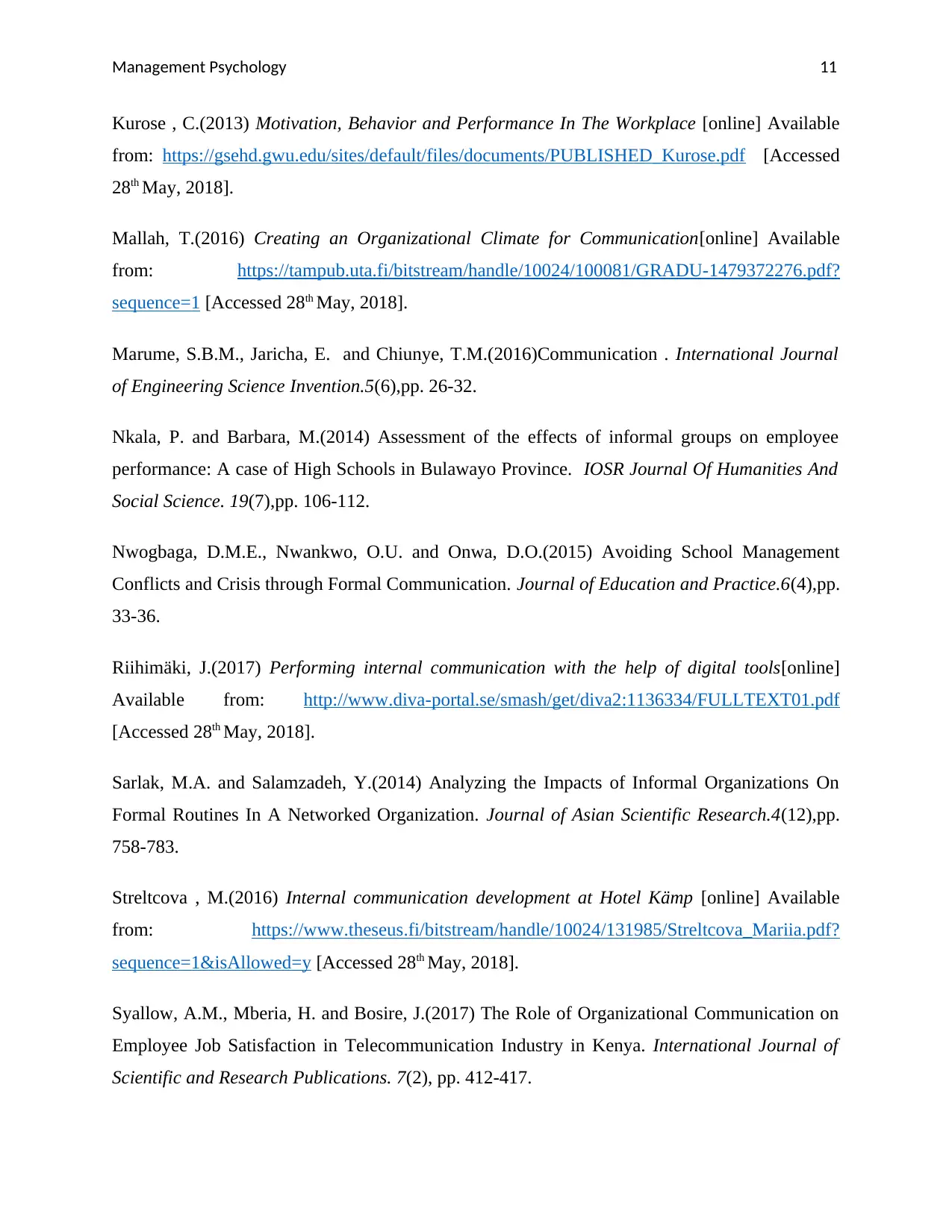
Management Psychology 11
Kurose , C.(2013) Motivation, Behavior and Performance In The Workplace [online] Available
from: https://gsehd.gwu.edu/sites/default/files/documents/PUBLISHED_Kurose.pdf [Accessed
28th May, 2018].
Mallah, T.(2016) Creating an Organizational Climate for Communication[online] Available
from: https://tampub.uta.fi/bitstream/handle/10024/100081/GRADU-1479372276.pdf?
sequence=1 [Accessed 28th May, 2018].
Marume, S.B.M., Jaricha, E. and Chiunye, T.M.(2016)Communication . International Journal
of Engineering Science Invention.5(6),pp. 26-32.
Nkala, P. and Barbara, M.(2014) Assessment of the effects of informal groups on employee
performance: A case of High Schools in Bulawayo Province. IOSR Journal Of Humanities And
Social Science. 19(7),pp. 106-112.
Nwogbaga, D.M.E., Nwankwo, O.U. and Onwa, D.O.(2015) Avoiding School Management
Conflicts and Crisis through Formal Communication. Journal of Education and Practice.6(4),pp.
33-36.
Riihimäki, J.(2017) Performing internal communication with the help of digital tools[online]
Available from: http://www.diva-portal.se/smash/get/diva2:1136334/FULLTEXT01.pdf
[Accessed 28th May, 2018].
Sarlak, M.A. and Salamzadeh, Y.(2014) Analyzing the Impacts of Informal Organizations On
Formal Routines In A Networked Organization. Journal of Asian Scientific Research.4(12),pp.
758-783.
Streltcova , M.(2016) Internal communication development at Hotel Kämp [online] Available
from: https://www.theseus.fi/bitstream/handle/10024/131985/Streltcova_Mariia.pdf?
sequence=1&isAllowed=y [Accessed 28th May, 2018].
Syallow, A.M., Mberia, H. and Bosire, J.(2017) The Role of Organizational Communication on
Employee Job Satisfaction in Telecommunication Industry in Kenya. International Journal of
Scientific and Research Publications. 7(2), pp. 412-417.
Kurose , C.(2013) Motivation, Behavior and Performance In The Workplace [online] Available
from: https://gsehd.gwu.edu/sites/default/files/documents/PUBLISHED_Kurose.pdf [Accessed
28th May, 2018].
Mallah, T.(2016) Creating an Organizational Climate for Communication[online] Available
from: https://tampub.uta.fi/bitstream/handle/10024/100081/GRADU-1479372276.pdf?
sequence=1 [Accessed 28th May, 2018].
Marume, S.B.M., Jaricha, E. and Chiunye, T.M.(2016)Communication . International Journal
of Engineering Science Invention.5(6),pp. 26-32.
Nkala, P. and Barbara, M.(2014) Assessment of the effects of informal groups on employee
performance: A case of High Schools in Bulawayo Province. IOSR Journal Of Humanities And
Social Science. 19(7),pp. 106-112.
Nwogbaga, D.M.E., Nwankwo, O.U. and Onwa, D.O.(2015) Avoiding School Management
Conflicts and Crisis through Formal Communication. Journal of Education and Practice.6(4),pp.
33-36.
Riihimäki, J.(2017) Performing internal communication with the help of digital tools[online]
Available from: http://www.diva-portal.se/smash/get/diva2:1136334/FULLTEXT01.pdf
[Accessed 28th May, 2018].
Sarlak, M.A. and Salamzadeh, Y.(2014) Analyzing the Impacts of Informal Organizations On
Formal Routines In A Networked Organization. Journal of Asian Scientific Research.4(12),pp.
758-783.
Streltcova , M.(2016) Internal communication development at Hotel Kämp [online] Available
from: https://www.theseus.fi/bitstream/handle/10024/131985/Streltcova_Mariia.pdf?
sequence=1&isAllowed=y [Accessed 28th May, 2018].
Syallow, A.M., Mberia, H. and Bosire, J.(2017) The Role of Organizational Communication on
Employee Job Satisfaction in Telecommunication Industry in Kenya. International Journal of
Scientific and Research Publications. 7(2), pp. 412-417.
⊘ This is a preview!⊘
Do you want full access?
Subscribe today to unlock all pages.

Trusted by 1+ million students worldwide
1 out of 13
Related Documents
Your All-in-One AI-Powered Toolkit for Academic Success.
+13062052269
info@desklib.com
Available 24*7 on WhatsApp / Email
![[object Object]](/_next/static/media/star-bottom.7253800d.svg)
Unlock your academic potential
Copyright © 2020–2025 A2Z Services. All Rights Reserved. Developed and managed by ZUCOL.




